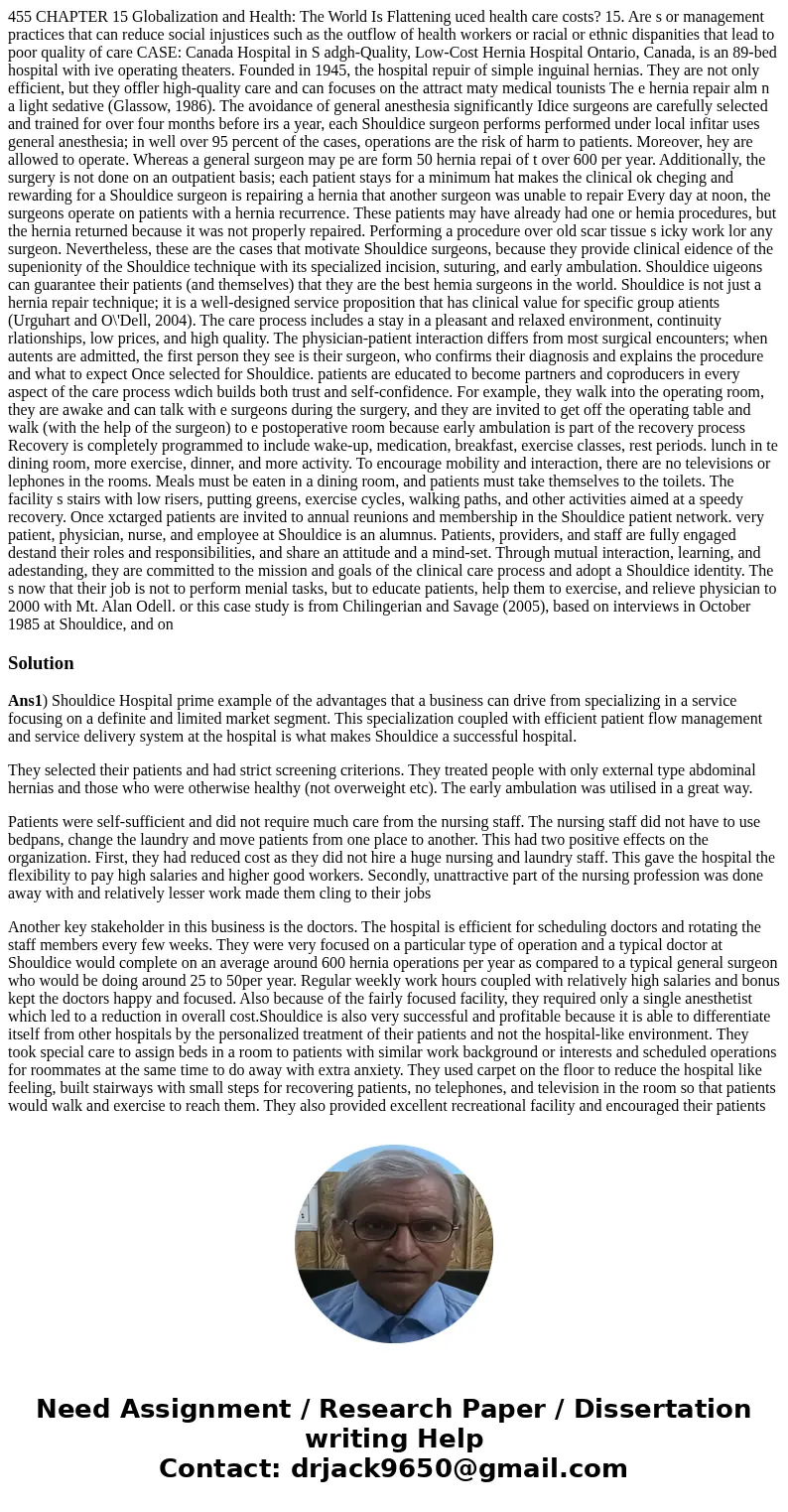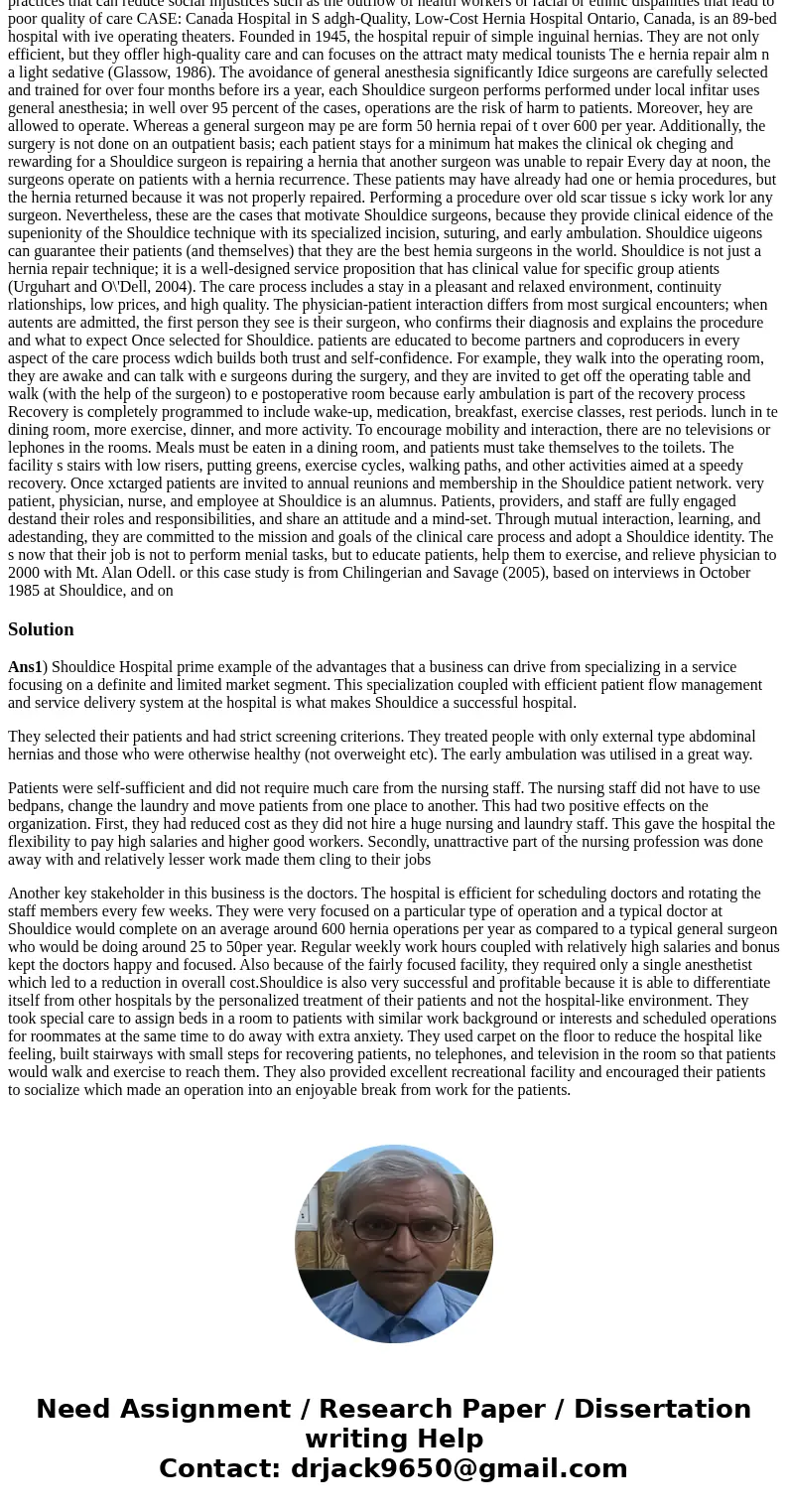455 CHAPTER 15 Globalization and Health: The World Is Flattening uced health care costs? 15. Are s or management practices that can reduce social injustices such as the outflow of health workers or racial or ethnic dispanities that lead to poor quality of care CASE: Canada Hospital in S adgh-Quality, Low-Cost Hernia Hospital Ontario, Canada, is an 89-bed hospital with ive operating theaters. Founded in 1945, the hospital repuir of simple inguinal hernias. They are not only efficient, but they offler high-quality care and can focuses on the attract maty medical tounists The e hernia repair alm n a light sedative (Glassow, 1986). The avoidance of general anesthesia significantly Idice surgeons are carefully selected and trained for over four months before irs a year, each Shouldice surgeon performs performed under local infitar uses general anesthesia; in well over 95 percent of the cases, operations are the risk of harm to patients. Moreover, hey are allowed to operate. Whereas a general surgeon may pe are form 50 hernia repai of t over 600 per year. Additionally, the surgery is not done on an outpatient basis; each patient stays for a minimum hat makes the clinical ok cheging and rewarding for a Shouldice surgeon is repairing a hernia that another surgeon was unable to repair Every day at noon, the surgeons operate on patients with a hernia recurrence. These patients may have already had one or hemia procedures, but the hernia returned because it was not properly repaired. Performing a procedure over old scar tissue s icky work lor any surgeon. Nevertheless, these are the cases that motivate Shouldice surgeons, because they provide clinical eidence of the supenionity of the Shouldice technique with its specialized incision, suturing, and early ambulation. Shouldice uigeons can guarantee their patients (and themselves) that they are the best hemia surgeons in the world. Shouldice is not just a hernia repair technique; it is a well-designed service proposition that has clinical value for specific group atients (Urguhart and O\'Dell, 2004). The care process includes a stay in a pleasant and relaxed environment, continuity rlationships, low prices, and high quality. The physician-patient interaction differs from most surgical encounters; when autents are admitted, the first person they see is their surgeon, who confirms their diagnosis and explains the procedure and what to expect Once selected for Shouldice. patients are educated to become partners and coproducers in every aspect of the care process wdich builds both trust and self-confidence. For example, they walk into the operating room, they are awake and can talk with e surgeons during the surgery, and they are invited to get off the operating table and walk (with the help of the surgeon) to e postoperative room because early ambulation is part of the recovery process Recovery is completely programmed to include wake-up, medication, breakfast, exercise classes, rest periods. lunch in te dining room, more exercise, dinner, and more activity. To encourage mobility and interaction, there are no televisions or lephones in the rooms. Meals must be eaten in a dining room, and patients must take themselves to the toilets. The facility s stairs with low risers, putting greens, exercise cycles, walking paths, and other activities aimed at a speedy recovery. Once xctarged patients are invited to annual reunions and membership in the Shouldice patient network. very patient, physician, nurse, and employee at Shouldice is an alumnus. Patients, providers, and staff are fully engaged destand their roles and responsibilities, and share an attitude and a mind-set. Through mutual interaction, learning, and adestanding, they are committed to the mission and goals of the clinical care process and adopt a Shouldice identity. The s now that their job is not to perform menial tasks, but to educate patients, help them to exercise, and relieve physician to 2000 with Mt. Alan Odell. or this case study is from Chilingerian and Savage (2005), based on interviews in October 1985 at Shouldice, and on
Ans1) Shouldice Hospital prime example of the advantages that a business can drive from specializing in a service focusing on a definite and limited market segment. This specialization coupled with efficient patient flow management and service delivery system at the hospital is what makes Shouldice a successful hospital.
They selected their patients and had strict screening criterions. They treated people with only external type abdominal hernias and those who were otherwise healthy (not overweight etc). The early ambulation was utilised in a great way.
Patients were self-sufficient and did not require much care from the nursing staff. The nursing staff did not have to use bedpans, change the laundry and move patients from one place to another. This had two positive effects on the organization. First, they had reduced cost as they did not hire a huge nursing and laundry staff. This gave the hospital the flexibility to pay high salaries and higher good workers. Secondly, unattractive part of the nursing profession was done away with and relatively lesser work made them cling to their jobs
Another key stakeholder in this business is the doctors. The hospital is efficient for scheduling doctors and rotating the staff members every few weeks. They were very focused on a particular type of operation and a typical doctor at Shouldice would complete on an average around 600 hernia operations per year as compared to a typical general surgeon who would be doing around 25 to 50per year. Regular weekly work hours coupled with relatively high salaries and bonus kept the doctors happy and focused. Also because of the fairly focused facility, they required only a single anesthetist which led to a reduction in overall cost.Shouldice is also very successful and profitable because it is able to differentiate itself from other hospitals by the personalized treatment of their patients and not the hospital-like environment. They took special care to assign beds in a room to patients with similar work background or interests and scheduled operations for roommates at the same time to do away with extra anxiety. They used carpet on the floor to reduce the hospital like feeling, built stairways with small steps for recovering patients, no telephones, and television in the room so that patients would walk and exercise to reach them. They also provided excellent recreational facility and encouraged their patients to socialize which made an operation into an enjoyable break from work for the patients.


 Homework Sourse
Homework Sourse